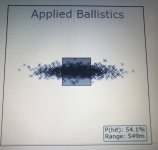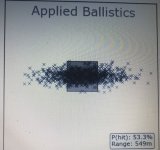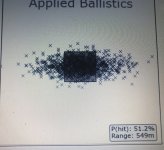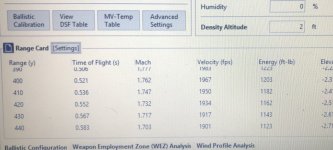- Joined
- Dec 20, 2019
- Messages
- 1,170
This is going to be a barrage of questions. It will help to view me as a skeptic relative to the matter at hand. I am going to do some load development for my new 6mm Creed. I live in the southeast where shots are rarely taken at more than 100 yards. But, I fancy that I will take a trip out west one day to hunt antelope, so I am going to do my load development with an eye toward the possibility that I might shoot out to say (for the sake of discussion) 500 yards. This is a hunting gun.
Time to order bullets. I see questions asked frequently across various forums asking about using XYZ match bullets for hunting. Why would I order a box of 95 grain TMKs? I realize at the ragged edge of reasonable hunting distances that the high BC bullets will show an advantage over less slippery bullets, is that what it's all about? Maybe my rifle will group hunting bullets into 3/4 of an inch and match bullets into a half? Is that what it's about? At what distance would that begin to matter?
Let's shift gears slightly. The .224 77 grain TMK is venerated here. The posters who sing its praises are very credible in my eyes. Based on the testimony of the posters here I have confidence that it will work well in Antelope hunting applications. Why would someone who was doing load development with that bullet seek it out as opposed to the Swift Scirocco 75 grain hunting bullet if there wasn't a substantial body of evidence that it works well?
Tying the first thoughts together, let's go back to my 6 Creed. Why would I try the TMK in my 6 Creed when the manufacturers website says this: "While they are recognized around the world for record-setting accuracy, MatchKing® and Tipped MatchKing® bullets are not recommended for most hunting applications. " Just because? As with the 224 77 TMK and the 75 Scirocco example, there are bullets that were designed for hunting that are very close to the match peers in BC. So why try the match? And when you answer that question, try to give me some substance as to how any perceived advantage may play out.
Lastly, if the .224 77 TMK is as good as I am led to believe it is, why in the world wouldn't Sierra bill it as a match/hunting bullet rather than warn consumers that it's not recommended for hunting? Wouldn't the dual purpose billing bring in more sales? Does Sierra know something our learned members here don't know? Do we know something that Sierra doesn't? The Sierra example is just one of several. Scenars would be another.
It's a rainy day and I took the day off. I have been pondering some of this for a while so I thought I'd toss it out there. I know there are lots of questions wrapped up in there. Take a stab at one or all.
Time to order bullets. I see questions asked frequently across various forums asking about using XYZ match bullets for hunting. Why would I order a box of 95 grain TMKs? I realize at the ragged edge of reasonable hunting distances that the high BC bullets will show an advantage over less slippery bullets, is that what it's all about? Maybe my rifle will group hunting bullets into 3/4 of an inch and match bullets into a half? Is that what it's about? At what distance would that begin to matter?
Let's shift gears slightly. The .224 77 grain TMK is venerated here. The posters who sing its praises are very credible in my eyes. Based on the testimony of the posters here I have confidence that it will work well in Antelope hunting applications. Why would someone who was doing load development with that bullet seek it out as opposed to the Swift Scirocco 75 grain hunting bullet if there wasn't a substantial body of evidence that it works well?
Tying the first thoughts together, let's go back to my 6 Creed. Why would I try the TMK in my 6 Creed when the manufacturers website says this: "While they are recognized around the world for record-setting accuracy, MatchKing® and Tipped MatchKing® bullets are not recommended for most hunting applications. " Just because? As with the 224 77 TMK and the 75 Scirocco example, there are bullets that were designed for hunting that are very close to the match peers in BC. So why try the match? And when you answer that question, try to give me some substance as to how any perceived advantage may play out.
Lastly, if the .224 77 TMK is as good as I am led to believe it is, why in the world wouldn't Sierra bill it as a match/hunting bullet rather than warn consumers that it's not recommended for hunting? Wouldn't the dual purpose billing bring in more sales? Does Sierra know something our learned members here don't know? Do we know something that Sierra doesn't? The Sierra example is just one of several. Scenars would be another.
It's a rainy day and I took the day off. I have been pondering some of this for a while so I thought I'd toss it out there. I know there are lots of questions wrapped up in there. Take a stab at one or all.







